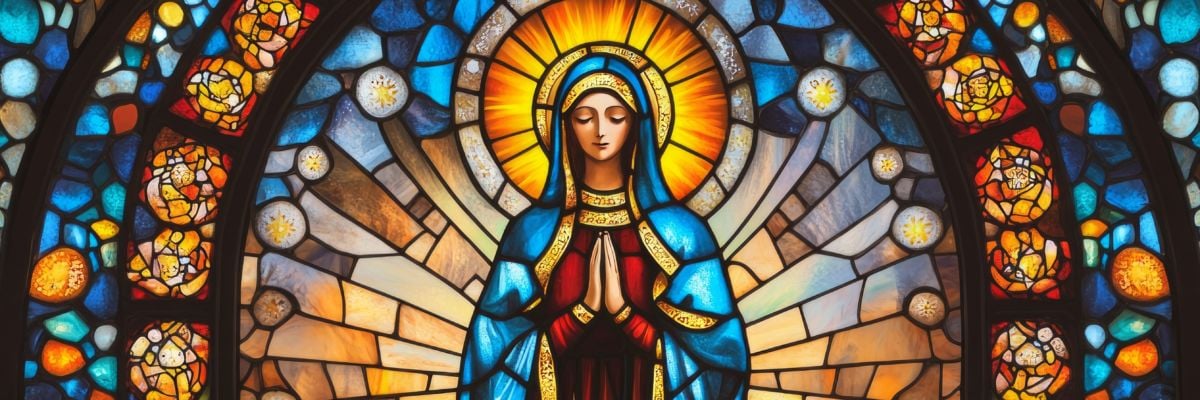
Cy Kellett and Trent Horn engage with a thoughtful question from Kim in China, Maine, who shares her journey toward understanding Catholicism and her struggle with the veneration of Mary.
Transcript:
Caller: I guess the problem I have and why I have a hard time completely embracing Catholicism, and maybe it’s with the understanding of what you actually believe surrounding it, but with the veneration of Mary. I know that there’s a difference between worship and veneration, right? But to me, it sets really hard for me to pray to a saint or to pray to Mary. I guess my big reasoning is looking at, you know, Hebrews 4 and seeing that, you know, we have a mediator that’s already sympathetic and, you know, we can come boldly before Christ and, you know, why. Why do we need to use another, you know, why would we need to use another person when we already have Christ there?
Trent: Right. Well, Kim, what Hebrews is talking about there in Hebrews chapter four is that there are no longer going to be, after Christ’s sacrifice, high priests who were succeeded one after another. They have been replaced with Jesus, who is our eternal high priest. So Jesus is the… The sacrifice of Christ on the cross is all that we need to obtain atonement from sin for the redemption of the world, so we don’t have to continually sacrifice bulls and animals. Even Christ himself does not have to be crucified again. Jesus is our eternal high priest, sacrificed once because he’s fully God and fully man. He’s able to stand in our place, or he’s able to atone for the sins of humanity. He’s able to represent all of us to the Father. And because he’s fully God, his sacrifice has infinite value.
So you’re correct. We look to Jesus as our high priest because his sacrifice on the cross is what brought about our redemption. However, when we see elsewhere in Scripture, we see that we are capable of praying for one another to help the graces from that sacrifice be accrued to others to alleviate burdens for other people. St. Paul says that we should each pray for one another. And if you look in Hebrews, you go forward in Hebrews to Hebrews 12:1, it talks about how there’s a cloud of witnesses, and it’s referring back to Hebrews 11, to all the heroes of the Old Testament that lived by faith.
Hebrews 12:1, the author says that they now, as we are surrounded by so great a cloud of witnesses, let us continue to run the race of perseverance. So the idea here is that Christ’s sacrifice on the cross is what atones for sins, is what redeems the world. But we are one body in Christ and we pray for one another. And in James 5:16, James says that the prayers of righteous people are very powerful. So if somebody’s closer to God, then naturally we would have more respect for them and admire them and venerate them because of that close relationship they have with God.
So why the big emphasis on Mary? Well, of all the human beings who ever lived, of all the human beings who ever lived, who had the closest relationship with Jesus Christ and still does. What do you think, Kim?
Caller: No, thank you. I really like the explanation. I guess my thought is why wouldn’t we have seen Mary play a more pivotal role in Jesus’ earthly ministry? And then secondly, I don’t know if you’ll have time to explain it, but a little bit more in-depth question on Mary. I don’t really understand the Catholic view of her as the Queen of Heaven. I know I’ve heard that term from some of my Catholic friends. Do you understand what I’m saying? I guess I don’t know if I was clear on that.
Trent: No, you certainly are. The first element would be about Mary’s role in the New Testament. And she doesn’t have a highly prominent role, not like Peter, for example, but she does play very important roles in the life of Christ. I mean, obviously, if we look at Christ’s childhood nativity, she is one of the starring figures there, basically that her “yes” is what brought Jesus into the world. But it seems to me your question is more, well, why don’t we see Mary more in Jesus’s public ministry and maybe through the early church?
And part of that may be attributed to Mary’s humbleness, that she’s the perfect person to practice humility. And so she is allowing Jesus and the apostles to go and preach the gospel. And we’d also have to remember, of course, that in ancient Israel, women were not as permitted to be able to travel and speak. They didn’t have as much authority as a man. So teaching, for example, and preaching were primarily reserved to men. Especially in the first-century Jewish culture in Palestine, women just simply did not have as much authority and in some places were looked down upon.
So I think what Mary is doing is that she’s offering her support to Jesus and she’s guiding people to Jesus. Because you remember the first miracle Jesus ever performed is at the wedding of Cana. And he did that after the servants there ran out of wine. They didn’t go straight to Jesus; they actually went to Mary first, and then Mary went to Jesus and Mary told the servants, “Do whatever he tells you.” And so that’s how we look at Mary, that she’s someone who always leads us to Christ.
And my question earlier, I wanted to hone in on that, that if Mary is the closest person to Jesus ever, still is in heaven, that she is his mom. I mean, this blows my mind kind of that God, that the second person of the Trinity, the eternal Son who has existed for all eternity, for the rest of eternity, he will look like a particular human being. He will. When we get to heaven and look at Mary and look at Jesus, we’ll see a resemblance. And this God will forever resemble a human being.
So for me, that just blows my mind and starts to put all the pieces of the puzzle together. That venerating Mary makes sense and doesn’t detract from Jesus any more than venerating a Picasso painting takes away from Picasso. Now, to the title of Queen of Heaven, that doesn’t mean that Mary is like married to Jesus, like king and queen in that way. It means more that in the Old Testament, like the king of Israel might have a lot of wives. Like Solomon had like 300 wives, because you’d marry someone to establish a treaty or, you know, with another kingdom, things like that.
So in the Old Testament, the kings of Israel, the queen was actually the king’s mother, and she kind of maintained peace in the household and she ruled alongside her son. So that the king, the queen was the king’s mother. So Solomon, for example, talks about how Bathsheba, remember David and Bathsheba? She was the, in Hebrew, Gabira, or the great lady, the queen. And the same would be true of Mary, that if Jesus is the king of God’s kingdom, he’s our king, then Mary is his mother. She inherits that title of Gabira, or great lady, and that she would be the queen of heaven.
And she’s not a tyrannical ruler. She doesn’t take away from Jesus. What she does is she obeys her son and leads everyone to him, that we are essentially her spiritual children, that we are all God’s adopted children. And so we look at the end of the Gospel of John that Jesus says to Mary, you know, he says to Mary about John, “Behold your son,” before he dies on the cross. And he tells John, “Behold your mother,” that Mary becomes the mother of the apostle John. And through tradition, we see Mary is actually now the mother of all Christians as she prays for us to always lead us closer to her son, Jesus.
So I hope that’s helpful for you. And really do call back if you have other questions. The best book I would recommend on Mary to really understand Mary more would be *Behold Your Mother* by my friend and colleague Tim Staples. So definitely check that book out.
Cy: Kim, thanks so much for that call. We do have to take a quick break. We’ll be right back with more of your calls on why you are not Catholic with Trent Horn, our guest today.



